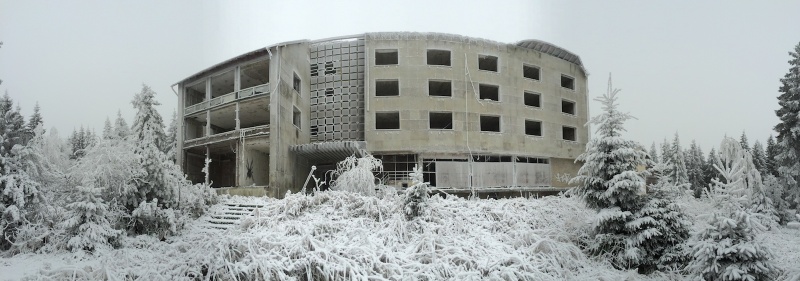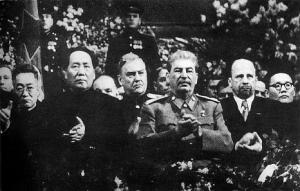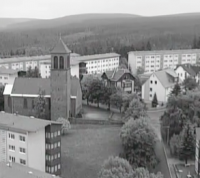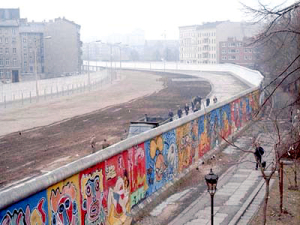
Socialism is one of those things that sounds great in principle but works poorly in practice, usually because of human nature’s exploitative streak. Take one Walter Ulbricht for example. A keen fan of Lenin, he was one of the founders of the Weimar-era Communist Party, and is so opposed to the principle of World War One that he deserts in 1917.
Communism isn’t all that popular in post-WW1 either, and when an activist is killed by police Ulbricht urges the first of many revenge murders; the lives of two policemen for each protestor. Unsurprisingly he falls out of favour with the rising Nazi party, and runs off to hide in Paris and then Prague following a public row with propaganda minister Joseph Goebbels. During World War Two he elopes to the Soviet Union, emerging to effectively found the DDR – Deutsche Demokratische Republik – on 7th October 1949 by placing himself at the head of the half of ruined Germany that the allies didn’t want.
Ulbricht was also a keen skier and enjoyed spending time in Germany’s version of St. Moritz. Situated in the middle of Thüringen’s pristine woodland, 800 meters above sea level, Oberhof had been the premier winter-sports town since the Kaiser’s time, drawing people from far and wide with it’s rural charms and relaxed atmosphere. All that was about to change. 1949 saw the inaugural Winter Sports Championship, a government attempt at injecting some feelgood-factor into the already dreary DDR. Attended by 90,000 people it’s a roaring success, and Ulbricht soon spots an opportunity for spreading Communist propaganda via his favourite hobbyhorse: sport. The next year’s championship would be even bigger, and Ulbricht finds a ready answer to the question of housing all those extra athletes, officials, and visitors.
On 13th November 1950, just one year into his term of office, he decides he likes Oberhof so much that he’s going to claim it in the name of Communism. 50 families – builders, bakers, hoteliers – are accused of Wirtschaftsverbrechen »Commercial Crimes« and given just two hours to leave town. They are resettled elsewhere, their lives confiscated, their properties acquired by Ulbricht’s Sports Committee in the first of many such operations throughout East Germany’s subsequent history. But Operation Oberhof was just beginning.
The entire town is dug up and rebuilt over the following years, new communal housing blocks used to eclipse the church so hated by Ulbricht – the first to be built in the DDR – and so easily removed from the skyline. There are no problems with planning permission or local opposition.
In time the confiscated properties are repurposed as FDGB holiday camps and put to use indoctrinating students in the communist ideal, while new hotels are added to provide to provide a few balloted hundred annually a glimpse of what real holiday feels like. One such hotel, the Panorama, is furnished with Western trimmings not available to the captives of the DDR, whose exposure to unaccustomed opulence is priced according to income. A fortnight surrounded by luxuries they’d never experience again cost people on average 129 Marks – a sick joke for a country which had no real use for actual currency since everybody was indirectly employed by the same government that owned everything you could spend your money on. Oberhof is lofted high, a shining example of how affordable a holiday could be under Communist rule.
But the people aren’t fooled. Economic deterioration is evident everywhere, and the country continues to haemorrhage citizens by the thousands as more and more escape to the West. Recognising this Ulbricht feels compelled to put a stop to all this Republiksflucht by reassuring the population with the famously ironic “Nobody has the intention of building a wall” speech. It’s the first time that “wall” is used in this context, and construction of the wall nobody intended to build starts just two months later.
In addition to the Iron Curtain, Walter Ulbricht also fashioned an opulent guest house in his favourite Ski resort, Oberhof. Construction began in 1960, having selected a prime location in the forest with his wife, Lotte. Architect Ehrhardt Simon draws up grand plans indeed, and materials required for heated floors and walls as well as air conditioning are quietly written off as part of the Civil Defence budget. The property sees it’s first major social use 9 years later, when senior party members are invited to celebrate New Year, 1969.
Yet no amount of social climbing nor party connections will herd the elephant from the room; the Unintended Wall gaffe continues to undermine Communist principles and becomes a festering thorn in the Soviets’ side. Ulbricht ultimately falls foul of party hard-liners like Erich Honecker and is forced to resign in May 1971, for reasons of poor health. He dies of a heart attack on 1 August 1973 at a government guest house, and is succeeded by Honecker.






Forgive the unusual history-to-photos ratio. As one who grew up behind Ulbricht’s ridiculous wall I’ll always have a stronger interest in these things than most people, and besides, it’s not every day you get the chance to relieve yourself in the fireplace of the man who imprisoned a nation. The real wonder is the ease with which I found this place. My trip had already been planned when I chanced across a photo of the ruined building, 2 minutes on Google confirmed the location, provided background, and I’ll be darned if it wasn’t on the route I’d already planned. Access? Couldn’t have been easier if they’d had valet parking …


